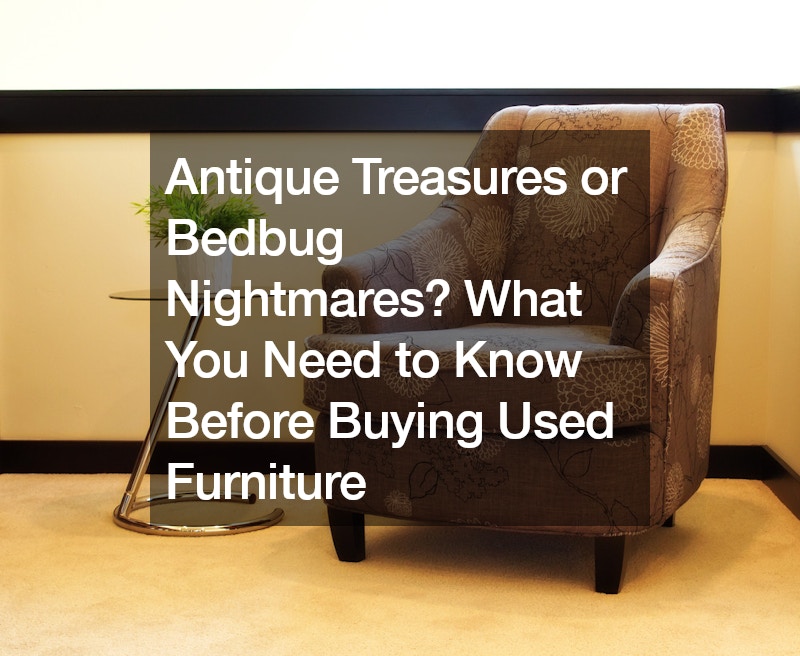
Antique and used furniture shopping has become increasingly popular, thanks to the charm of vintage pieces and the excitement of finding unique treasures. However, along with these potential finds comes a significant risk that many buyers overlook: the possibility of bringing bedbugs into your home. Understanding this risk and learning how to inspect used furniture can help you avoid a potential infestation and make the most of your antique shopping experience.
The Charm of Antique Furniture
Antique furniture offers a unique blend of history, craftsmanship, and character that new furniture often lacks. Whether it’s a beautiful Victorian armchair, a rustic farmhouse table, or an elegant Art Deco lamp, antiques can add a touch of charm and sophistication to any space.
Platforms like Facebook Marketplace, estate sales, and local antique shops make it easier than ever to discover these one-of-a-kind pieces.
The Hidden Danger: Bedbugs
While the excitement of finding a vintage gem is undeniable, it’s essential to be aware of the hidden risks associated with used furniture. One of the most concerning issues is the potential for bedbugs. Bedbugs are small, parasitic insects that feed on blood and can hide in the smallest crevices of furniture. An infestation can quickly spread throughout your home, leading to discomfort and costly treatments.
Bedbugs are adept at hiding in furniture, especially in upholstered items like sofas, chairs, and mattresses. They can cling to fabrics, wood joints, and even cracks in the furniture’s structure. When you bring a piece of used furniture into your home, you risk introducing these pests to your living space. Unlike hotels, where bedbug issues are often highlighted in the media, used furniture presents a more subtle but equally dangerous source of bedbug infestations.
How to Inspect Used Furniture for Bedbugs
Before you purchase any used or antique furniture, it’s crucial to conduct a thorough inspection to check for signs of bedbugs. Here are some steps to help you ensure that your antique treasure doesn’t turn into a bedbug nightmare:
1. Examine Upholstery Closely
Check the seams, cushions, and fabric folds for small, reddish-brown stains or dark spots. These could be signs of bedbug feces or crushed bedbugs. Pay close attention to areas where the fabric meets the frame, as these can be common hiding spots for bedbugs.
2. Inspect the Wooden Parts
Look for signs of bedbugs on wooden components, such as legs, armrests, or under the furniture. Bedbugs often leave small, rust-colored stains or tiny eggs that may be visible on wood surfaces. You might also see tiny, shed bedbug skins in these areas.
3. Check for Bedbug Eggs and Casings
Bedbug eggs are tiny, white, and oval-shaped, while casings are translucent and may look like empty shells. These can be found in hidden areas, so use a flashlight to inspect hard-to-see places.
4. Look for Bedbug Bites
Although this is more of a secondary indicator, if you notice unexplained bites on your skin, especially in a linear pattern, it might be worth re-examining your furniture for bedbugs.
5. Ask the Seller Questions
Don’t hesitate to ask the seller about the history of the furniture. Inquire if the piece has been in storage if it was ever treated for pests, or if there have been any issues with bedbugs in the past.
Prevention Tips for Used Furniture
Once you’ve inspected the furniture and decided to make a purchase, there are additional steps you can take to minimize the risk of bringing bedbugs into your home:
1. Clean the Furniture Thoroughly
Before bringing the furniture inside, clean it thoroughly. Vacuum the entire piece, including the upholstery, and use a steam cleaner if possible. Steam cleaning can kill bedbugs at all stages of their life cycle.
2. Use Bedbug Treatments
Consider using bedbug-specific treatments like sprays or powders designed to kill bedbugs. Apply these treatments to the furniture according to the instructions to ensure any potential pests are dealt with.
3. Re-Upholstery
For upholstered furniture, don’t hesitate to enlist the services of trusted re-upholstery experts. Re-upholstering can involve stripping down the old fabric and replacing it with new material, which updates the look of the furniture while helping eliminate any hidden bedbugs and their eggs.
4. Isolate the Furniture
If possible, keep the furniture in a separate, enclosed space, like a garage or a well-ventilated area, for a few days before bringing it into your home. This can help to ensure that any bedbugs are dealt with before they reach your living space.
5. Keep Your Home Clean
Maintaining cleanliness in your home can help to prevent bedbug infestations. Regularly vacuuming, washing bedding, and inspecting for signs of bedbugs can help to keep your home free of pests.
6. Hire Pest Control Experts
If you suspect that the used furniture you purchased may have bedbugs, or if you notice signs of an infestation after bringing it home, it’s important to seek professional pest control services. Bedbug infestations can be challenging to manage on your own, and a professional can provide effective treatments to protect your home.
Final Thoughts
Antique and used furniture can be a wonderful addition to your home, offering unique character and history. However, it’s crucial to be aware of the risks, especially the potential for bedbug infestations. So next time you’re on the hunt for that perfect antique piece, remember these tips to make sure your treasure stays a joy rather than a headache!
.

